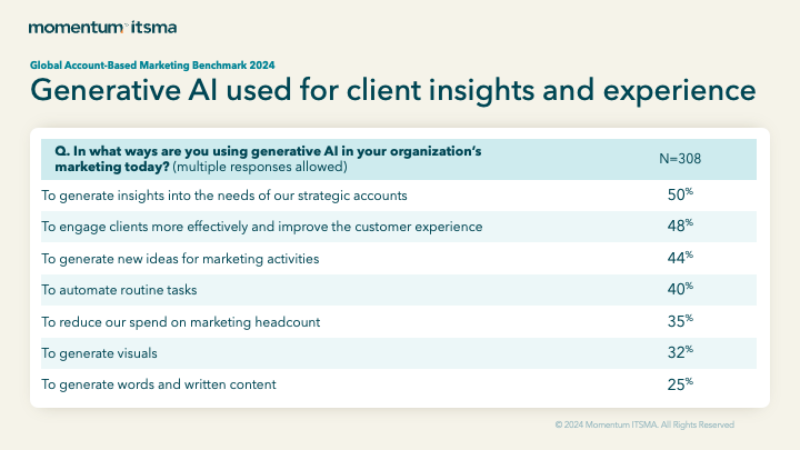Understanding the generative AI marketing chasm
Based on data from our new Global Account-Based Marketing Benchmark (ABX) research, I believe we're seeing the emergence of a phenomenon I'm calling the "generative AI marketing chasm”.
We surveyed over 300 marketing leaders from B2B organizations valued between $100m and $10b+ on issues ranging from their OKRs to martech maturity. The data indicates that virtually every organization has started to adopt generative AI in their marketing activity. Most of those organizations report they are either considering/investigating it (22%), exploring potential use cases (32%), and implementing it on a limited scale (38%).
Fewer than 10% of the marketers we surveyed said they were expanding their usage of generative AI across multiple areas.
Not surprising, you might say. It's too early to expect more progress. But it does suggest there's a degree of caution when it comes to scaling the adoption of generative AI and thus a large gap between those leading the charge and those lagging behind – hence the generative AI marketing chasm.
It's not as if use cases are difficult to find. Across all company sizes, the most popular use case is to generate insights into the needs of strategic accounts. This seems a straightforward use case – anyone familiar with the 7-step ABM methodology advocated by Momentum ITSMA (and there are many of you out there!) will immediately recognize the potential value here. Although, given generative AI's occasional propensity to spout nonsense, it needs guard rails.
The second most popular use case for generative AI is arguably more ambitious and broader in scope: deploying generative AI to engage clients more effectively and improve the customer experience.
Perhaps most surprising is how few marketers seem to be tapping into generative AI for its most basic advantage: written content. Just 25% of respondents said they were using the technology to write marketing material.

So, what's holding companies back from using generative AI more widely? What factors are responsible for the chasm? Here are five possibilities, but very interested to hear your thoughts:
Inertia. There are too many use cases to pursue, from automating routine tasks to reducing headcount, which means marketers are struggling to determine the one that will bring them the most value. As one respondent put it: “We’re not sure where to prioritize our efforts”. (We’ve developed a Generative AI Prioritization Model to help alleviate this particular challenge. Contact Adam.Bennington@momentumitsma.com if you’d like a demo.)
Enthusiasm is waning. People generally are less gung-ho about generative AI this year compared to last. In Gartner-speak, we may have passed the “peak of inflated expectations” and are headed for the “trough of disillusionment.”
Security concerns. There are legitimate apprehensions about data privacy, compliance and governance, especially when it relates to clients. There are substantial technical issues that organizations must address.
Conflicting priorities. Marketing is already being asked to do an awful lot of heavy lifting and, right now, this might be one step too far. In our survey, for example, we asked about marketing’s priorities for the next 12 months and the to-do list is formidably and scarily long!
- Lack of expertise. We’ve all experimented with generative AI, but in truth, deep domain expertise and know-how are in short supply. Marketing is light in terms of the right caliber of people to fully leverage generative AI and finds it difficult to recruit those it needs.
We'll be sharing more detailed data on marketing's generative AI adoption when we formally launch our latest ABX survey on November 7th. Sign up here.
More in
-
The great B2B marketing reset: Why your team’s skills will define your success and growth trajectory
We read about it and we hear it all the time in our conversations with our clients: B2B marketing is under pressure like never before.
-
How future-ready B2B marketing teams win: Insights from the front lines of enablement
As an L&D Director working with top global B2B marketing teams, Jo Connolly reveals why enablement is the new growth engine – and how you can close the skills gap. Discover key findings and join our webinars for actionable strategies.
-
Transforming thought leadership into a client growth lever | Forbes
Thought leadership has transformed from a brand-building exercise into a pivotal element of enterprise decision making. It’s not just about generating interest; it's about securing trust, driving differentiation, and actively influencing purchase decisions.
